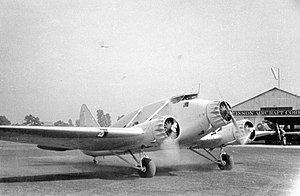Stinson Model A
| Stinson Model A | |
|---|---|
 |
|
| Role | Airliner |
| National origin | United States |
| Manufacturer | Stinson Aircraft Company |
| First flight | April 27, 1934 |
| Primary user | American Airlines |
| Number built | 31 |
| Unit cost |
$37,000 in 1934
|
The Stinson Model A was a moderately successful airliner of the mid-1930s. It was one of the last commercial airliners designed in the United States with a fabric-covered steel tube fuselage before the introduction of stressed skin aluminum construction.
A total of 30 Stinson Model As were built until production ceased in 1936. It was one of many promising designs whose commercial success was cut short by the introduction of the stressed-skin Boeing 247 and Douglas DC-2.
Because the waiting lists for either the new Boeing or Douglas aircraft were already too long Airlines of Australia (AOA) ordered three Stinson Model As in January 1936. These aircraft were VH-UGG Lismore (arrived per s.s. City of Winchester on 27 March), VH-UHH Brisbane (arrived per s.s. Wichita on 22 June) and VH-UKK Townsville (arrived 22 July in the s.s. City of Manilla). All three were quickly reassembled and entered the Sydney - Brisbane service, proving so successful that in August AOA ordered a fourth example VH-UYY Grafton – the very last Stinson Model A to be built – which arrived at Sydney on board s.s. Port Alma on 14 December.
With posturing from both AOA and Australian National Airways (ANA) to cut into each other’s turf by late 1936, early efforts by ANA to gain a controlling interest in AOA failed, until the tragic losses of VH-UHH Brisbane in the McPherson Ranges on 19 February 1937 and VH-UGG Lismore on 28 March halved AOA’s main-line fleet. A merger took effect in March 1937, although the two companies retained separate identities until AOA was formally absorbed into ANA on 1 July 1942. The two surviving Stinsons were then renamed VH-UKK Binana and VH-UYY Tokana, in conformity with ANA nomenclature.
During the Second World War spare parts for the Stinsons' aging Lycoming R-680 engines were impossible to obtain in Australia and it was decided to re-engine both aircraft with a Pratt & Whitney R-1340 Wasp engine on each wing and eliminate the engine on the nose. The additional power allowed both aircraft to fly faster and carry heavier loads, although fuel dumps had to be fitted to allow them to remain under their maximum landing weight of 10,750 lb (4,876 kg), in case of an emergency necessitating landing shortly after take-off.
...
Wikipedia
